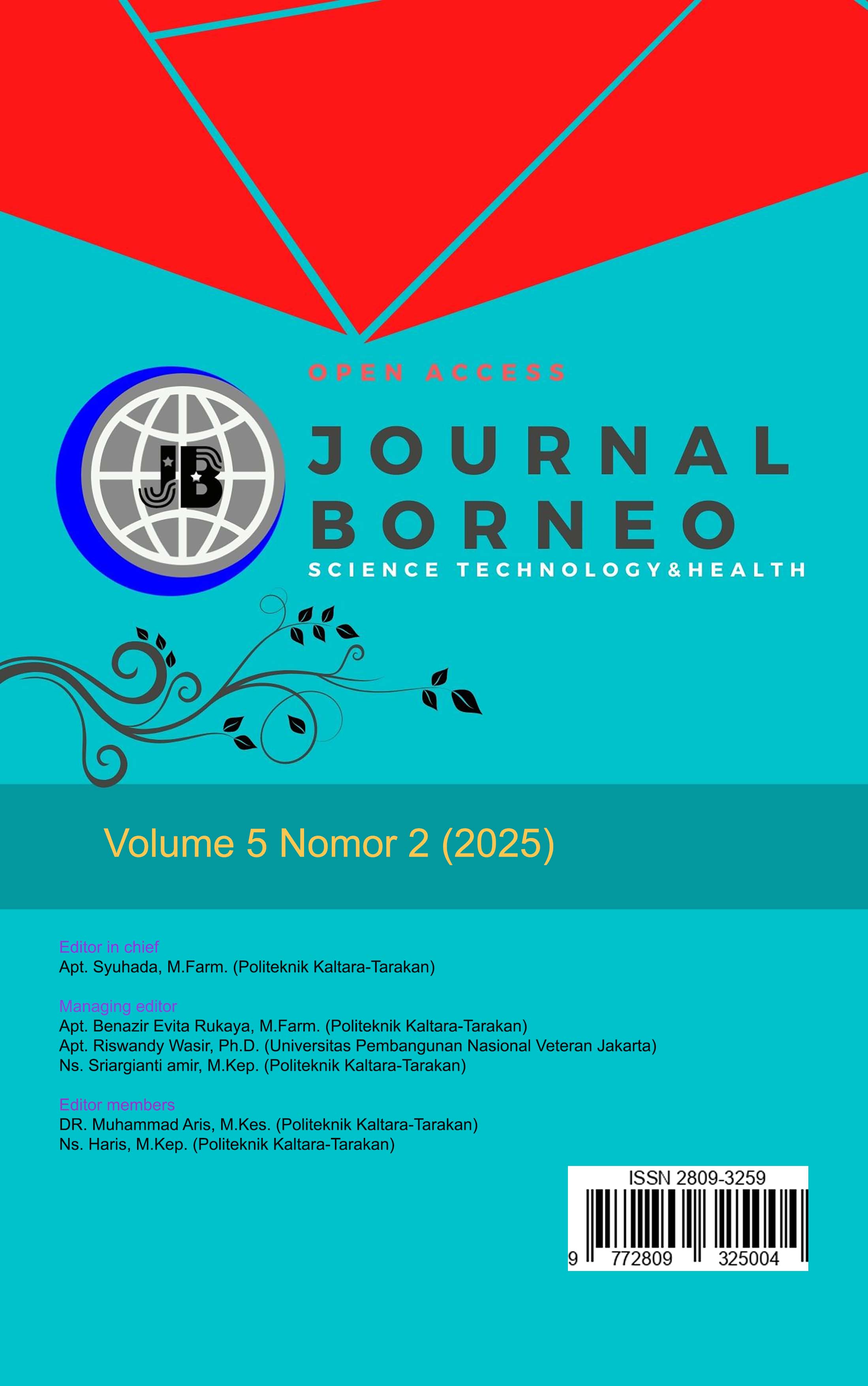Vol. 5 No. 2 (2025): Volume 5 Issue 2 tahun 2025

● Articles: 3 (+3)
● Editor in chief: apt. Syuhada, M.Farm.
● Managing Editor: apt. Benazir Evita Rukaya, M.Farm.
Articles
-
The Effectiveness of Small Group Discussions in Improving Knowledge, Attitudes, and Compliance of Adolescent Girls in Consuming Iron
 Abstract: 383
|
Abstract: 383
|  PDF 54-65 (Indonesian): 112
PDF 54-65 (Indonesian): 112
Abstract
Anemia is a health problem frequently experienced by adolescent girls, one of which is caused by insufficient iron intake. Health education is essential in improving knowledge, attitudes, and compliance with iron tablet consumption in adolescents. Health education can be conducted using various methods, including small group discussions. This study aims to analyze the effectiveness of health education using the small group discussion method on the knowledge, attitudes, and compliance of adolescent girls in consuming iron. The quantitative research design uses a quasi-experimental pre-test-post-test with a control group. Data analysis uses statistical tests. Paired T-test and Cohen's effect size. The research sample consisted of 64 respondents using a purposive sampling technique. The instrument used was a questionnaire to assess knowledge, attitudes, and compliance with iron consumption. The results of statistical analysis using the paired T-test showed a significant increase in the intervention group compared to the control group in aspects of knowledge (p < 0.05), attitudes (p < 0.05), and compliance with iron consumption (p < 0.05). The Cohen's effect test analysis results revealed knowledge, attitudes, and compliance with iron consumption, respectively, and obtained values of 1.3, 1.6, and 0.5. So it can be concluded that health education using the small group discussion method effectively improves adolescent girls' knowledge, attitudes, and compliance in consuming iron.
-
The Influence of the Role of Mothers, Teachers, and the Presence of Cigarette Vendors on Student Smoking Behavior in Bantul
 Abstract: 187
|
Abstract: 187
|  PDF 66-78 (Indonesian): 116
PDF 66-78 (Indonesian): 116
Abstract
Indonesia ranks first with the highest smoking prevalence in ASEAN, according to the Tobacco Atlas. The tendency to smoke among adolescents aged <15 years increased by 2.1% in the 2017–2020 period, driven by curiosity, the desire to appear tough, and the sensation of pleasure and calmness from smoking. Important factors in preventing adolescent smoking behavior come not only from government policies, but also from the role of parents, teachers, and the environment around the school, especially the presence of retail cigarette sellers. This study aims to analyze the relationship between the roles of parents, teachers, and retail cigarette sellers with the smoking behavior of high school students. The method used was quantitative with a cross-sectional design. A sample of 62 students was selected by random sampling, with an instrument in the form of a questionnaire. Data analysis was performed using the Chi-Square test. The results showed a significant correlation between the roles of parents, teachers, and retail cigarette sellers with student smoking behavior. It was concluded that these three factors have a significant influence on preventing adolescent smoking behavior. This finding emphasizes the importance of synergy between parents, teachers, and schools to reduce the number of teenage smokers sustainably.
-
The Influence of Leaflet Media on the Knowledge, Attitudes and Actions of Mothers with Kindergarten-Age Children in Accelerating the Reduction of Stunting in Tarakan City
 Abstract: 178
|
Abstract: 178
|  PDF 79-89 (Indonesian): 89
PDF 79-89 (Indonesian): 89
Abstract
Stunting is a global health problem that causes long-term impacts on children’s quality of life, particularly in terms of physical growth, cognitive development, and future productivity. Mothers’ knowledge of the impacts of stunting remains low. This study aims to analyze the effect of leaflet media on the knowledge, attitudes, and practices of mothers with kindergarten-aged children in accelerating stunting reduction. Methods: This was a quantitative study with a pretest–posttest research design. The respondents were 80 mothers who had kindergarten-aged children in Tarakan City, North Kalimantan. Results: Knowledge: In the intervention group, the respondents’ knowledge score before the intervention was 10.95 ± 0.45, and after the intervention, it increased to 12.83 ± 1.53; p = 0.000. The control group also showed an increase in knowledge, but the final score was lower compared to the intervention group, although still statistically significant (p = 0.000). Attitudes: In the intervention group, the attitude score significantly increased from 13.45 ± 1.03 before the intervention to 14.58 ± 2.62 after the intervention. In the control group, the score changed from 13.88 ± 0.46 before the intervention to 13.90 ± 1.63 after the intervention; however, the change was not statistically significant (p = 0.928). Practices: In the intervention group, practices significantly improved from 10.00 ± 0.55 before the intervention to 11.20 ± 2.13 after the intervention (p = 0.001). In the control group, practices also showed a significant increase from 10.43 ± 1.05 to 11.75 ± 1.93 (p = 0.000). Recommendation: The use of QR codes in leaflets can be applied so that mothers can access additional information in the form of videos or other interactive materials.
-
Impact of Diabetic Foot Exercise Program on Glycemic Control in Type 2 Diabetes Mellitus Patients
 Abstract: 278
|
Abstract: 278
|  PDF 90-102 (Indonesian): 65
PDF 90-102 (Indonesian): 65
Abstract
Background: Type 2 diabetes mellitus (DM) is a chronic metabolic disease characterized by hyperglycemia due to insulin resistance and impaired insulin secretion. Physical activity, such as foot exercises, is known to play a role in lowering blood glucose levels. Objective: To determine the effect of diabetic foot exercises on changes in blood glucose levels in patients with type 2 DM in the Gunung Lingkas Community Health Center (Puskesmas) in Tarakan City. Methods: This study used a quasi-experimental design with a pre-test and post-test approach. A sample of 18 respondents was selected using a purposive sampling technique. The intervention, in the form of diabetic foot exercises, was carried out in a structured manner with a duration of 20–30 minutes per session, given three times per week for four weeks. The foot exercises were guided by the researcher following standard movement procedures including warm-up, core movements, and cool-down. Random blood glucose levels were measured using a glucometer before the intervention (pre-test) and after the intervention (post-test) to determine the effectiveness of the exercise. Results: The average blood glucose level before the foot exercise was 216,57 mg/dl, and after the intervention it became 183,92 mg/dl, with an average decrease of 32,65 mg/dl. Statistical testing showed a p-value of 0,001 (p < 0.05), indicating a significant effect. Conclusion: Diabetic foot exercises significantly reduce blood glucose levels in patients with type 2 diabetes and can be implemented as a non-pharmacological intervention at the primary care level.
Pharmacy
-
The Effectiveness of Using Single Antihypertension Drugs, Angıotensın II Receptor Blockers (ARB) and Calcium Channel Blockers (CCB) in Ischemic Stroke Patients at the Inpatient Unit of Dr. Soedirman Hospital, Kebumen in 2024
 Abstract: 82
|
Abstract: 82
|  PDF 103-108 (Indonesian): 33
PDF 103-108 (Indonesian): 33
Abstract
The increasing prevalence of ischemic stroke with hypertension demands optimal blood pressure control. At Dr. Soedirman Regional General Hospital, Calcium Channel Blockers (CCB) and Angiotensin II Receptor Blockers (ARB) are the main choices for monotherapy antihypertensive due to their effectiveness and mild side effect profiles. This study aimed to compare the effectiveness of ARB and CCB monotherapy in ischemic stroke patients admitted to the inpatient ward of Dr. Soedirman Regional General Hospital in 2024. The research employed a descriptive-analytic method with a cross-sectional design and retrospective data. A total of 112 patients meeting the inclusion criteria were selected using total sampling. Therapeutic effectiveness was analyzed using the Mann-Whitney test. The results showed that most patients were over 65 years old (64.29%) and male (50.89%). Both therapies effectively reduced blood pressure to the target of <140/90 mmHg. Statistical analysis revealed no significant difference between ARB and CCB use (p=0.995; p>0.05). The study concludes that ARB and CCB are equally effective in lowering blood pressure in ischemic stroke patients without significant differences. Further prospective studies are recommended to evaluate side effects, patient quality of life, and cost-effectiveness.























